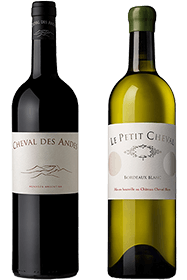Beyond its chivalrous name, imbued with heroism, Château Cheval Blanc embodies the excellence of the prestigious Saint-Émilion appellation: explore all the subtleties of this exceptional estate.
Location and vineyard area
Recognized worldwide, this emblematic Right Bank estate has maintained an almost unchanged configuration since 1871: 39 hectares in one block, divided into 45 parcels, with vines averaging 42 years old. This unique organization allows for particularly precise parcel management, with each parcel benefiting from its own soil and grape variety characteristics. Located at about forty meters altitude, on the quaternary alluvium of the Isle (a non-limestone formation mixing gravel and clay), Cheval Blanc shares a remarkable geological kinship with the greatest crus of Pomerol.
Château Cheval Blanc: A centuries-old heritage
The history of Cheval Blanc dates back to Roman times, but the estate truly takes shape in the 19th century, notably from 1832 with the acquisition of the vineyard's heart by Jean-Jacques Ducasse. The union of Henriette Ducasse and Jean Laussac-Fourcaud marks a turning point: the latter modernizes the property and opts, from the 1860s, for an innovative grape variety mix combining equal parts Merlot and Cabernet Franc. The first wine marketed under the name Cheval Blanc dates from 1852. Since then, the estate has known only one major succession, ensuring remarkable continuity in its management.
An exceptional terroir
Terroir, exposure and climate The vineyard extends over a gravelly ridge on the border of the Pomerol appellation, in Saint-Émilion. The parcels benefit from varied exposures and topographies, offering a great diversity of microclimates conducive to terroir expression. The estate's geological mosaic, inherited from ancient glaciers of the Massif Central, gives the wine remarkable complexity and aging capacity. The temperate oceanic climate typical of Bordeaux benefits from the regulating influence of rivers, favoring optimal grape ripeness.
Cultural practices and commitments
The estate is a pioneer in agroecology. Initiated several years ago, this dynamic translates into the implementation of practices such as polyculture, cover crops, soil preservation, planting of fruit and forest trees, biodiversity development, and beehive installation...
Winemaking and aging
Each parcel is vinified separately to reveal its full potential before final blending. Aging, traditionally carried out in oak barrels, receives meticulous attention to preserve the finesse and elegance of the wines.
Wine style: elegance and power as symbols
The wines of Château Cheval Blanc, renowned for their elegance, finesse and complexity, are distinguished by a unique blend of Merlot and Cabernet Franc. They develop subtle red fruit aromas, floral notes and silky tannins. Their remarkable aging potential allows them to gain depth and complexity over the years.
Grand Vin: Château Cheval Blanc
Mainly from Cabernet Franc and Merlot, it is distinguished by a dense structure, aromatic depth and silky tannins. Full and fresh on the palate, it blends red and black fruit aromas, floral, spicy, licorice notes and sometimes mocha or eucalyptus. Renowned for its exceptional aging potential, it gains harmony and complexity with time.
Second wine: Le Petit Cheval
Le Petit Cheval, the estate's second wine, benefits from the same care as the Grand Vin, but aims to be more accessible, with a more supple structure and expression focused on fruit and freshness. Accessible earlier, it seduces with its balance, finesse and gourmandise, while expressing the estate's singularity in a charming style.
The white wine: Le Petit Cheval Blanc
Le Petit Cheval Blanc is the estate's white wine, composed mainly of Sauvignon Blanc. Pure, fresh and mineral, it reveals notes of citrus, white flowers and white-fleshed fruits. Its taut and elegant palate illustrates the estate's demands and know-how.
























